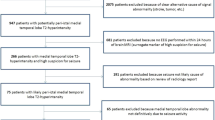Abstract
We studied the role of early diffusion-weighted imaging DWI in the investigation of children with new-onset prolonged seizures which eventually result in unilateral hippocampal sclerosis (HS). We carried out MRI on five children aged 17 months to 7 years including conventional and diffusion-weighted sequences. We calculated apparent diffusion coefficients (ADC) for the affected and the normal opposite hippocampus. Follow-up examinations were performed, including DWI and ADC measurements in four. We studied four children within 3 days of the onset of prolonged psychomotor seizures and showed increased signal on T2-weighted images, and DWI, indicating restricted diffusion, throughout the affected hippocampus. The ADC were reduced by a mean of 14.4% in the head and by 15% in the body of the hippocampus. In one child examined 15 days after the onset of seizures, the ADC were the same on both sides. All five patients showed hippocampal atrophy on follow-up 2–18 months later. In the four patients in whom ADC were obtained on follow-up, they were increased by 19% in the head and 17% in the body. DWI may represent a useful adjunct to conventional MRI for identifying acute injury to the hippocampus which results in sclerosis.

Similar content being viewed by others
References
Zhong J, Petroff OAC, Prichard JW, Gore JC (1993) Changes in water diffusion and relaxation properties of rat cerebrum during status epilepticus. Magn Reson Med 30: 241–246
Righini A, Pierpaoli C, Alger JR, Di Chiro G (1004) Brain parenchyma apparent diffusion coefficient alterations associated with experimental complex partial status epilepticus. Magn Reson Med 12: 865–871
Wieshmann UC, Symms MR, Shorvon SD (1997) Diffusion changes in status epilepticus. Lancet 350: 493–494
Lansberg MG, O’Brien MW, Norbash AM, Moseley ME, Morrell M, Albers GW (1999) MRI abnormalities associated with partial status epilepticus. Neurology 52: 1021–1027
Diehl B, Najm I, Ruggieri P, et al (1999) Periictal diffusion-weighted imaging in a case of lesional epilepsy. Epilepsia 40: 1667–1671
Kim JA, Chung JI, Yoon PH, et al (2001) Transient MR signal changes in patients with generalized tonicoclonic seizure or status epilepticus: periictal diffusion-weighted imaging. AJNR 22: 1149–1160
Wieshmann UD, Clark CA, Symms MR, Barker GJ, Birnie KD, Shorvon SD (1999) Water diffusion in the human hippocampus in epilepsy. Magn Reson Imaging 17: 29–36
Hugg JW, Butterworth EJ, Kuzniecky RI (1999) Diffusion mapping applied to mesial temporal lobe epilepsy. Neurology 53: 173–176
Yoo SY, Chang KH, Song IC, et al (2002) Apparent diffusion coefficient value of the hippocampus in patients with hippocampal sclerosis and in healthy volunteers. AJNR 23: 809–812
Kantarci K, Shin C, Britton JW, So EL, Cascino GD, Jack Jr CR (2002) Comparative diagnostic utility of 1H MRS and DWI in evaluation of temporal lobe epilepsy. Neurology 58: 1745–1753
Diehl B, Najm I, Ruggieri P, et al (2001) Postictal diffusion-weighted imaging for the localization of focal epileptic areas in temporal lobe epilepsy. Epilepsia 42: 21–28
Mohamed A, Wyllie E, Ruggieri P, et al (2001) Temporal lobe epilepsy due to hippocampal sclerosis in pediatric candidates for epilepsy surgery. Neurology 56: 1643–1649
Falconer MA, Serafetinides EA, Corsellis JAN (1964) Etiology and pathogenesis of temporal lobe epilepsy. Arch Neurol 10: 233–240
Falconer MA (1971) Genetic and related aetiological factors in temporal lobe epilepsy. Epilepsia 12: 13–31
VanLandingham KE, Heinz ER, Cavazos JE, Lewis DV (1998) Magnetic resonance imaging evidence of hippocampal injury after prolonged focal febrile convulsions. Ann Neurol 43: 413–126
Jackson GD, Chambers BR, Berkovic SF (1999) Hippocampal sclerosis: development in adult life. Dev Neurosci 21: 207–214
Tien RD, Felsberg GI (1995) The hippocampus in status epilepticus: demonstration of signal intensity and morphologic changes with sequential fast-spin-echo imaging. Radiology 194: 249–256
Briellmann RS, Newton MR, Wellard RM, Jackson GD (2001) Hippocampal sclerosis following brief generalized seizures in adulthood. Neurology 57: 315–317
Nohria V, Lee N, Tien RD, et al (1994) Magnetic resonance imaging evidence of hippocampal sclerosis in progression: a case report. Epilepsia 35: 1332–1336
Cox JE, Mathews VP, Santos CC, Elster AD (1995) Seizure-induced transient hippocampal abnormalities on MR: correlation with positron emission tomography and electroencephalography. AJNR 16: 1736–1738
Oikawa H, Sasaki M, Tamakawa Y, Kamei A (2001) The circuit of Papez in mesial temporal sclerosis: MRI. Neuroradiology 43: 205–210
Cavazos JE, Das I, Sutula TP (1994) Neuronal loss induced in limbic pathways by kindling: evidence for induction of hippocampal sclerosis by repeated brief seizures. J Neurosci 14: 3106–3121
Beltram EH, Lothman EW, Lenn NJ (1990) The hippocampus in experimental chronic epilepsy: a morphometric analysis. Ann Neurol 27: 43–48
Cavazos JE, Sutula TP (1990) Progressive neuronal loss induced by kindling: a possible mechanism for mossy fiber synaptic reorganization and hippocampal sclerosis. Brain Res 527: 1–6
Van Paesschen W, Duncan JS, Stevens JM, Connelly A (1998) Longitudinal quantitative hippocampal magnetic resonance imaging study of adults with newly diagnosed partial seizures: one-year follow-up results. Epilepsia 39: 633–639
Briellmann RS, Berkovic SF, Syngeniotis A, King MA, Jackson GD (2002) Seizure-associated hippocampal volume loss: a longitudinal magnetic resonance study of temporal lobe epilepsy. Ann Neurol 51: 641–644
Nakasu Y, Nakasu S, Morikawa S, Uemura S, Inubushi T, Handa J (1995) Diffusion-weighted MR in experimental sustained seizures elicited with kainic acid. AJNR 16: 1185–1192
Wang Y, Majors A, Najim I, et al (1996) Postictal alteration of sodium content and apparent diffusion coefficient in epileptic rat brain induced by kainic acid. Epilepsia 1996;37: 1000–1006
Nedelcu J, Klein MA, Aguzzi A, Boesiger P, Martin E (1999) Biphasic edema after hypoxic-ischemic brain injury in neonatal rats reflects early neuronal and late glial damage. Pediatr Res 46: 297–304
Koepp MJ (2000) Hippocampal sclerosis: cause or consequence of febrile seizures. J Neurol 69: 716–717
Author information
Authors and Affiliations
Corresponding author
Rights and permissions
About this article
Cite this article
Farina, L., Bergqvist, C., Zimmerman, R.A. et al. Acute diffusion abnormalities in the hippocampus of children with new-onset seizures: the development of mesial temporal sclerosis. Neuroradiology 46, 251–257 (2004). https://doi.org/10.1007/s00234-003-1122-x
Received:
Accepted:
Published:
Issue Date:
DOI: https://doi.org/10.1007/s00234-003-1122-x




